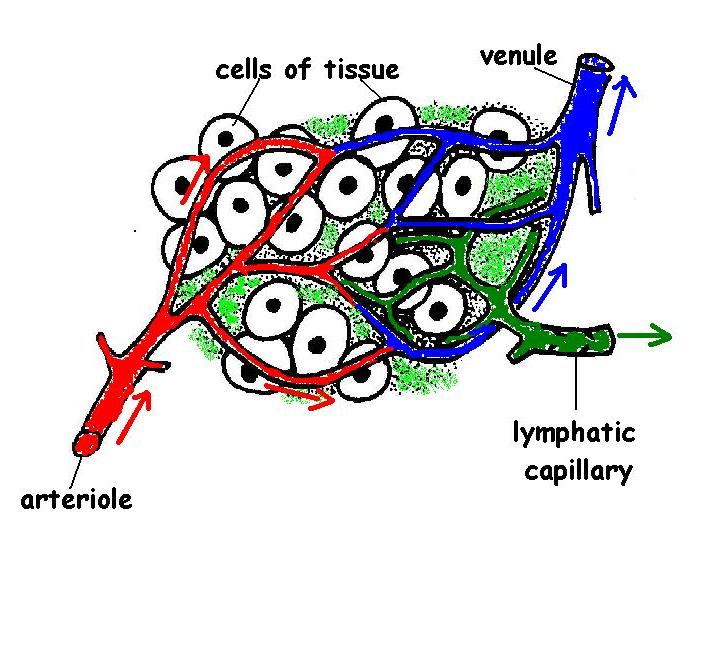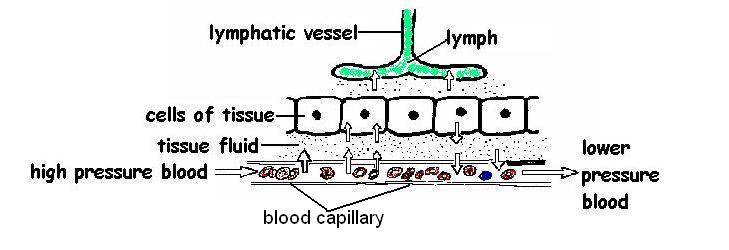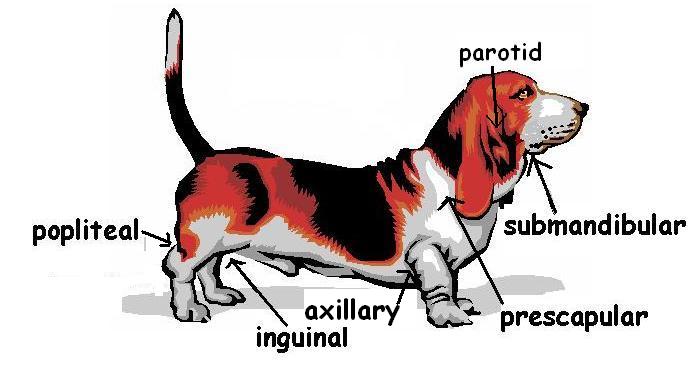The Anatomy and Physiology of Animals/Lymphatic System Worksheet/Worksheet Answers
1. a. Add labels or colour in the diagram of a capillary bed and associated lymphatic vessels.
2. How is tissue fluid formed? Tissue fluid is the fluid that leaves the capillaries to surround the cells of the tissues. Water leaves the capillaries by osmosis and substances like salts, amino acids and glucose generally move by diffusion.
3. Add the following labels to the diagram showing the formation of lymph below.
- Blood capillary; blood entering capillary at high pressure; blood leaving capillary at low pressure
- tissue fluid; lymph; lymphatic vessel; cells of tissue
4. Compare plasma, serum, tissue fluid and lymph by filling in the cells in the table below.
| Blood plasma | Serum | Tissue fluid | Lymph | |
|---|---|---|---|---|
| Definition/where found | Clear fluid
part of blood |
Fluid left
when blood clots |
Fluid surrounding
cells. Formed from plasma |
Fluid in
lymphatic vessels |
5. When lymph has entered the lymphatics, how does it make its way back to the blood stream? Lymph flows along the lymphatic vessels pushed along by the contraction of the muscles surrounding them. Valves prevent it flowing backwards. It flows through at least one lymph node before rejoining the blood circulation via a vessel cranial to the heart.
6. This is a function of lymph nodes:
- b) Filtering bacteria and debris from lymph
7. Mark the positions of the following lymph nodes on the picture of the dog below.
- Popliteal; superficial inguinal; submandibular prescapular; parotid
8. Name three organs of the lymphatic system (other than lymph nodes).
- i. Spleen
- ii. Thymus
- iii Lymph nodules e.g Peyer's patches
- iv Bone marrow
9. List three functions of the lymphatic system
- i. Filtering debris, bacteria etc. from the lymph.
- ii. Producing lymphocytes.
- iii.Returning fluid to the circulatory system.
10.
True or false?
- i. A major function of lymph nodes is to filter foreign substances from the lymph. T
- ii. Lymphatic vessels are identical in structure to veins. F The walls of lymphatics are much thinner (1 cell thick) than those of veins (many cells thick).
- iii. The heart beat helps push lymph along lymphatic vessels. F The heart beat has no effect on lymph flow. The contraction of the muscles surrounding the lymphatic vessels is the main mechanism that pushes lymph along.
- iv. The cisterna chyli and thoracic duct are parts of the lymphatic system. T
- v. The spleen is the largest lymphatic organ. T
- vi. The spleen is an important store of white blood cells. F The spleen stores red blood cells.
- vii. The thymus gland is located cranially to the heart T
- viii. A major function of the thymus is to produce monocytes. F The thymus produces and modifies lymphocytes.
- ix. Peyers patches are located in the wall of the stomach. F Peyer's patches are small lymph nodes located in the wall of the small intestine.
- x. The lymphatic system sometimes transports cancer cells around the body. T


